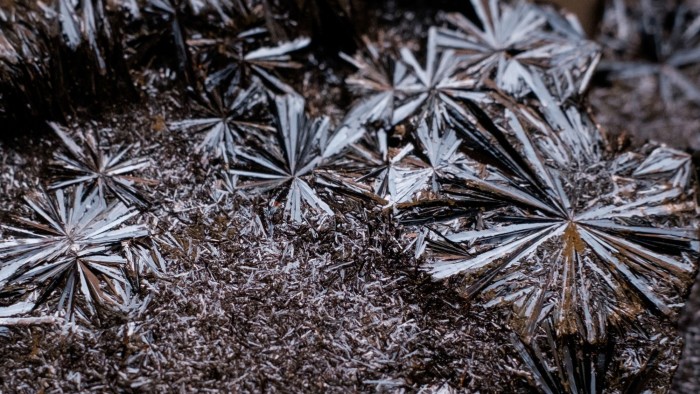Unlock the Editor’s Digest for free
Roula Khalaf, Editor of the FT, selects her favourite stories in this weekly newsletter.
What makes a mineral critical? Governments and markets may take different views. Vanadium, which appears on the official US list, is getting no special treatment from commodity buyers. Despite a few spikes, the benchmark price is down over five years and companies focused on element number 23 have largely given investors a rough ride.
A stellar performance last week by Vanadium Resources may presage a broader change in fortunes: shares in the Australian developer nearly doubled after it inked an agreement to supply vanadium-rich magnetite to a Chinese metals dealer.
Vanadium earns its stripes for steel-strengthening properties. These are key for defence and aerospace, but also useful in buildings and infrastructure. China is the world’s biggest consumer. Its weak property sector has contributed to the mineral’s price weakness.
But vanadium is also shaping up as a viable alternative for energy storage, especially over long timeframes. Vanadium redox flow batteries (VRFBs) are big and have poor energy density, ruling them out for electric vehicles and gadgets. But they are also non corrosive and boast a longer shelf life; indeed, as a recyclable element it technically has an infinite life cycle.
For now, VRFBs play a somewhat niche role: for cyclone-resistant grids in the Pacific isles, say, and account for maybe 8 per cent of overall demand. But the global push for technologies that can store energy for extended periods — where VRFBs play a part alongside lithium technologies — could lift demand. One industry body, the Long Duration Energy Storage Council, is calling for 8 terawatts of long-duration deployment by 2040, implying a 50-fold increase.
Possible beneficiaries include energy storage battery maker Invinity, listed on London’s junior Aim market, Westwater Resources in the US and Canada’s vertically-integrated Largo. The latter, with Brazilian mines and processing, moved further up the chain following a recently-signed joint venture with manufacturer Stryten Energy.
They could use the boost. The trio are down 70-80 per cent over the past five years. Bushveld Minerals, which mines and processes vanadium, fell apart at the seams amid falling vanadium prices and operational mis-steps; shares were delisted from Aim in May. Two years before that trading in the London-listed shares of Evraz was suspended after the Russian integrated steel, mining and vanadium business was placed under sanctions.
Life has been tough for vanadium bulls, given the impact of sluggish steel demand. But now, its potential use in batteries could add a new source of demand. While governments have set more store by vanadium than markets, its role in storing energy could yet change that.
louise.lucas@ft.com
https://www.ft.com/content/babd683d-5a74-4076-82a4-9db304f45f73


